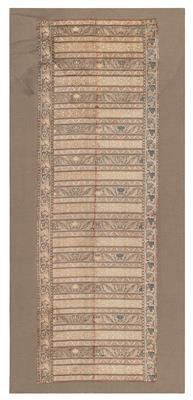Polish Sash Fragment,

Istanbul (Turkey), c. 102 (110) x 34 (50) cm, late 17th century, silk brocades such as the present one were initially produced in Keshan and exported via Turkey to Poland for the Polish higher nobility, but soon Armenians living in Constantinople took over the production of such sashes due to the high demand. In the 18th century, weaving manufactories were also established in Poland. The best-known local producers were Paschalis Jakubovicx and Paschal Lamm, who monogrammed their pieces and wove them with foldable designs. Sashes, such as the present one, used to be worn by the Polish elite as a belt over the “kontusz” robe, as a status accessory, exposing the simpler side on weekdays and the lavishly decorated one on Sunday. The present piece is decorated on only one side, without monogram, and must hence be regarded as an early, extremely rare item from the Orient. Continuous silver brocading and silk floral embroidery. This sash, with an original length of c. 270 cm, has been preserved only in part, both finishes trimmed, edge damage and a vertical crease running through the middle of the textile, mounted on linen and stretcher.
Further reading:
Jan Samek, Polskie Rzemioslo; Louise W. Mackie, Symbols of Power.
Esperto: Vincent Pillinger
 Vincent Pillinger
Vincent Pillinger
+43-1-515 60-314
vincent.pillinger@dorotheum.at
05.11.2019 - 16:00
- Prezzo di partenza:
-
EUR 1.000,-
Polish Sash Fragment,
Istanbul (Turkey), c. 102 (110) x 34 (50) cm, late 17th century, silk brocades such as the present one were initially produced in Keshan and exported via Turkey to Poland for the Polish higher nobility, but soon Armenians living in Constantinople took over the production of such sashes due to the high demand. In the 18th century, weaving manufactories were also established in Poland. The best-known local producers were Paschalis Jakubovicx and Paschal Lamm, who monogrammed their pieces and wove them with foldable designs. Sashes, such as the present one, used to be worn by the Polish elite as a belt over the “kontusz” robe, as a status accessory, exposing the simpler side on weekdays and the lavishly decorated one on Sunday. The present piece is decorated on only one side, without monogram, and must hence be regarded as an early, extremely rare item from the Orient. Continuous silver brocading and silk floral embroidery. This sash, with an original length of c. 270 cm, has been preserved only in part, both finishes trimmed, edge damage and a vertical crease running through the middle of the textile, mounted on linen and stretcher.
Further reading:
Jan Samek, Polskie Rzemioslo; Louise W. Mackie, Symbols of Power.
Esperto: Vincent Pillinger
 Vincent Pillinger
Vincent Pillinger
+43-1-515 60-314
vincent.pillinger@dorotheum.at
|
Hotline dell'acquirente
lun-ven: 09.00 - 18.00
kundendienst@dorotheum.at +43 1 515 60 200 |
| Asta: | Tappeti orientali, tessuti, arazzi |
| Tipo d'asta: | Asta in sala |
| Data: | 05.11.2019 - 16:00 |
| Luogo dell'asta: | Wien | Palais Dorotheum |
| Esposizione: | 30.10. - 05.11.2019 |
